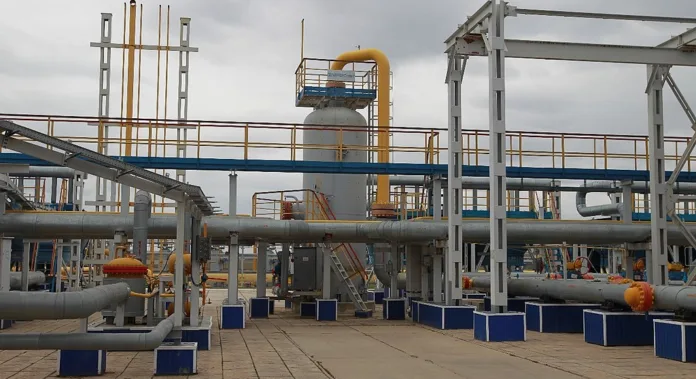Hawiyah gas storage facility, developed by Aramco, launches to inject up to 2 billion cubic feet of natural gas into Saudi Arabia’s energy system, supporting Vision 2030 goals
Saudi Arabia has taken a significant step in its energy infrastructure by launching its first natural gas storage facility at Hawiyah. Developed by Saudi Aramco, this cutting-edge project is set to inject up to 2 billion standard cubic feet of processed natural gas per day into the Kingdom’s Master Gas System. The extensive gas network, which connects major production and processing facilities to consumers nationwide, will now benefit from greater energy security and efficiency.
The Ministry of Energy shared the announcement on X (formerly Twitter), explaining that the facility will play a key role in managing the nation’s growing energy demands. With peak periods of consumption putting stress on resources, the storage facility will help stabilize supply, ensuring natural gas can be reintroduced to meet these needs without relying heavily on liquid fuels.
This project is part of the broader Liquid Fuel Displacement Program, which is central to Saudi Arabia’s ambitious Vision 2030 plan. The Kingdom aims to reduce its dependency on crude oil and petroleum-based fuels by substituting them with cleaner energy alternatives like natural gas and renewables. By 2030, Saudi Arabia expects to displace 1 million barrels of liquid fuel daily from utilities, agriculture, and industry, transitioning the nation toward generating 50% of its electricity from renewable sources.
Embed from Getty ImagesSaudi Aramco has been at the forefront of these developments, not only focusing on national initiatives but also expanding its reach into international markets. Last year, Aramco made its first foray into the liquefied natural gas (LNG) sector by acquiring a minority stake in MidOcean Energy, a venture owned by EIG Global Energy Partners. This $500 million deal marked a strategic partnership that builds on Aramco’s global ambitions. MidOcean is actively acquiring interests in several Australian LNG projects, positioning itself for global growth.
This shift towards natural gas and renewables is being bolstered by the National Center for Environmental Compliance, which aims to support private-sector industries in Saudi Arabia in moving away from environmentally harmful products. The initiative aims to replace production processes that contribute to ozone depletion and global warming with cleaner, more sustainable alternatives.
Through these developments, Saudi Arabia continues to assert itself as a global energy leader, leveraging its vast resources and strategic location to meet the growing demands of energy while reducing its carbon footprint and fostering economic diversification.
Analysis
Political: The launch of Saudi Arabia’s first natural gas storage facility is a significant political achievement for the Kingdom as it underscores the government’s commitment to Vision 2030. This initiative serves as a demonstration of Saudi Arabia’s drive to reduce its reliance on oil, diversify its economy, and transition toward a more sustainable energy model. The project not only strengthens the Kingdom’s energy security but also aligns with international climate agreements, helping Saudi Arabia present itself as a responsible global actor in the fight against climate change. Furthermore, this move could elevate the country’s geopolitical standing as it becomes a more prominent player in the global natural gas market, reducing its dependency on oil exports alone.
Social: From a social standpoint, the project could improve the quality of life for Saudi citizens by stabilizing energy supplies and reducing the Kingdom’s carbon footprint. Cleaner energy sources like natural gas can reduce air pollution, leading to better public health outcomes. This is particularly important as Saudi Arabia continues to urbanize and modernize its infrastructure. The transition to more sustainable energy sources also fosters greater awareness and support for environmental conservation among the population. The Hawiyah facility could serve as a model for how the Kingdom can balance modernization with environmental stewardship, promoting a culture of sustainability within its society.
Gender: The energy sector has traditionally been male-dominated, but Saudi Arabia’s ongoing reforms as part of Vision 2030 include efforts to increase female participation in various industries, including energy. The natural gas sector, with its new developments like the Hawiyah facility, could open doors for women to enter technical and managerial roles, contributing to the Kingdom’s economic diversification. Moreover, as renewable and cleaner energy initiatives gain momentum, gender equality can be integrated into these sectors, ensuring women have equal opportunities in this evolving industry.
Economic: Economically, the Hawiyah Gas Storage facility marks a pivotal step in Saudi Arabia’s diversification strategy. By enhancing its natural gas infrastructure, the Kingdom is reducing its dependence on oil and positioning itself as a key player in the global natural gas market. This diversification is crucial for ensuring long-term economic stability, especially given the volatility of oil prices in recent years. The facility also supports domestic industries by providing a reliable and cleaner energy source, which can reduce operational costs and improve competitiveness. Additionally, the international ventures of Saudi Aramco, such as its investment in MidOcean Energy, suggest that the Kingdom is looking to capture a larger share of the global LNG market, opening up new revenue streams and strengthening its economy on the global stage.
